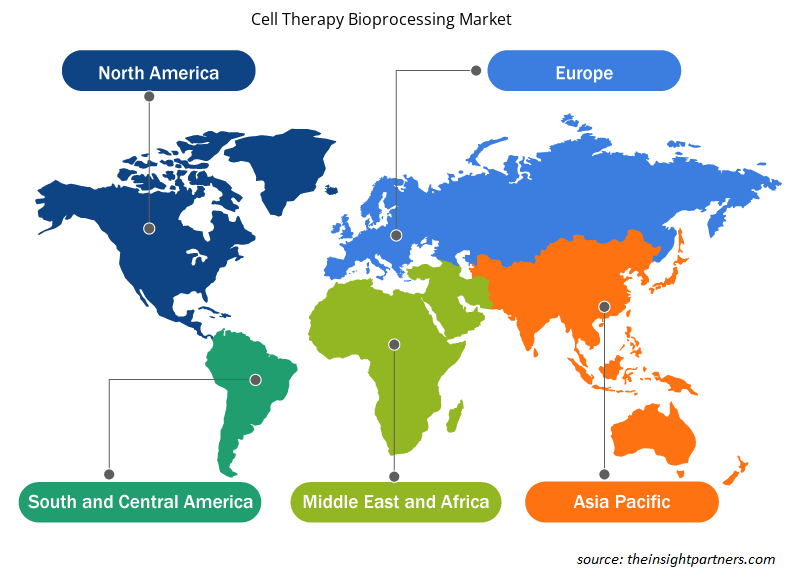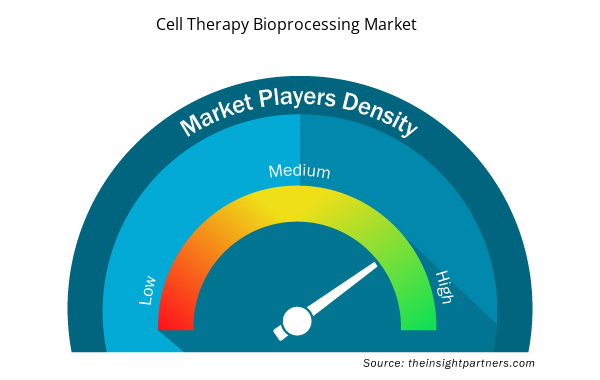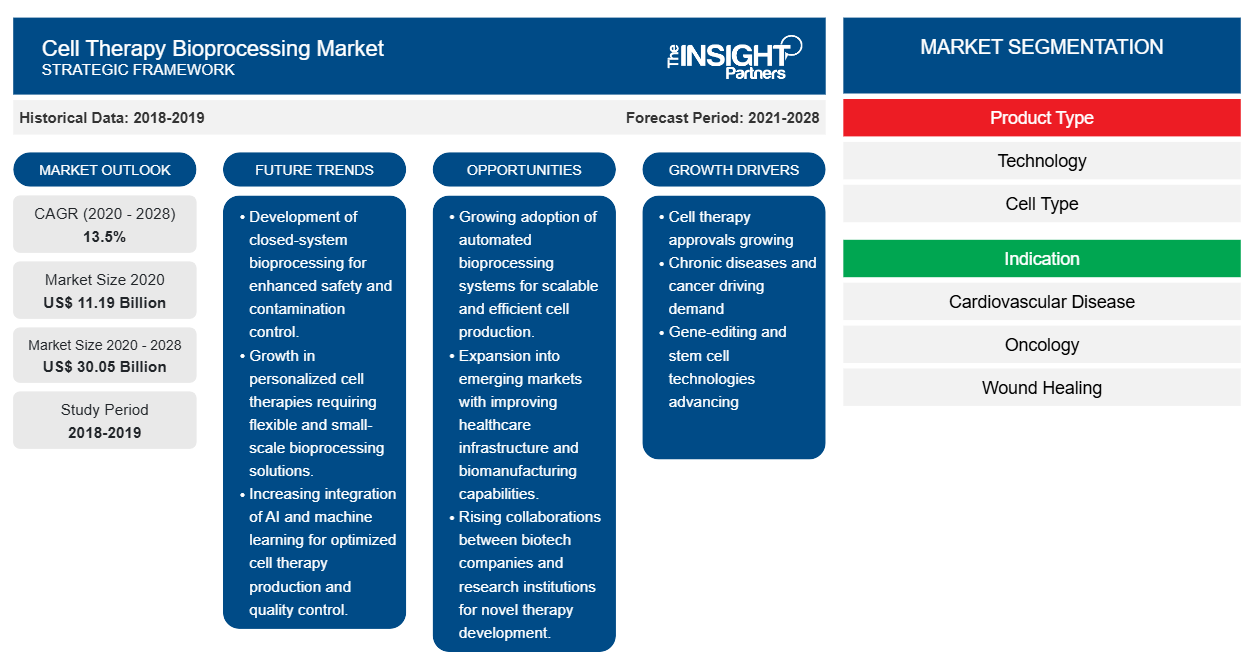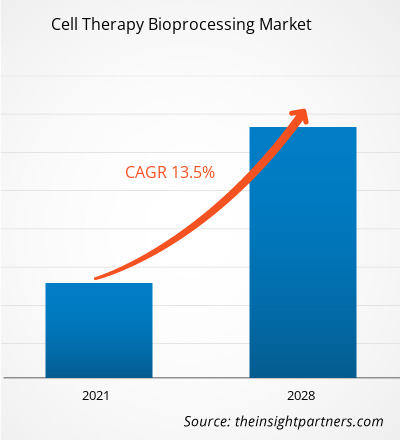من المتوقع أن يصل حجم سوق معالجة الخلايا الحيوية إلى 30،052.61 مليون دولار أمريكي في عام 2028 من 11،192.50 مليون دولار أمريكي في عام 2020. ومن المتوقع أن ينمو السوق بمعدل نمو سنوي مركب قدره 13.5٪ من 2021 إلى 2028.
تم تحليل سوق المعالجة الحيوية للعلاج الخلوي على أساس التكنولوجيا ونوع الخلية والمستخدم النهائي والمنطقة. يتم تقسيم السوق على أساس المنطقة إلى أمريكا الشمالية وأوروبا وآسيا والمحيط الهادئ والشرق الأوسط وأفريقيا وأمريكا الجنوبية والوسطى. يركز التقرير على معايير مثل اتجاهات السوق والتقدم التكنولوجي وديناميكيات السوق وتحليل المشهد التنافسي للشركة الرائدة لتقديم رؤى وتحليل متعمق لسوق المعالجة الحيوية للعلاج الخلوي . كما يتضمن تحليل جائحة COVID-19 عبر السوق في جميع المناطق الرئيسية.
قم بتخصيص هذا التقرير ليناسب متطلباتك
ستحصل على تخصيص لأي تقرير - مجانًا - بما في ذلك أجزاء من هذا التقرير، أو تحليل على مستوى الدولة، وحزمة بيانات Excel، بالإضافة إلى الاستفادة من العروض والخصومات الرائعة للشركات الناشئة والجامعات
- احصل على أهم اتجاهات السوق الرئيسية لهذا التقرير.ستتضمن هذه العينة المجانية تحليلاً للبيانات، بدءًا من اتجاهات السوق وحتى التقديرات والتوقعات.
رؤى السوق
الموافقات المتزايدة على علاجات الخلايا
لقد أظهرت علاجات الخلايا نتائج إيجابية في علاج العديد من الأمراض المزمنة بما في ذلك الاضطرابات الوراثية النادرة من خلال تقديم الأدوية التجديدية والأدوية المخصصة. وقد دفعت الحاجة المتزايدة لعلاج الأمراض المزمنة أنشطة البحث والتطوير مما أدى إلى زيادة إنتاج علاجات الخلايا وموافقات المنتجات. فيما يلي بعض الأمثلة على موافقات علاجات الخلايا التي ساهمت في نمو سوق المعالجة الحيوية لعلاج الخلايا.
- في مايو 2019، وافقت إدارة الغذاء والدواء (FDA) على عقار Zolgensma، الذي تصنعه شركة AveXis, Inc. وهي شركة تابعة لشركة Novartis AG. تم تصميم عقار Zolgensa لعلاج ضمور العضلات الشوكي لدى الأطفال دون سن الثانية ويتم إعطاؤه عن طريق الحقن مرة واحدة في الوريد.
- في يوليو 2020، حصلت شركة Kite Pharma, Inc.، وهي شركة تابعة لشركة Gilead Company، على موافقة إدارة الغذاء والدواء الأمريكية على عقار Tecartus. Tecartus هو علاج بالخلايا التائية (CAR) مصمم لعلاج ليمفوما الخلايا الردائية المقاومة (MCL) لدى البالغين. ووفقًا لشركة Gilead Company، فإن Tecartus هو أول علاج بالخلايا التائية (CAR) معتمد لمرض ليمفوما الخلايا الردائية، والذي من المتوقع أن يكون بمثابة آفاق جديدة في علاج ليمفوما الخلايا الردائية.
- في فبراير 2021، حصلت شركة Juno Therapeutics, Inc.، وهي شركة تابعة لشركة Bristol-Myers Squibb Company، على موافقة على Breyanzi. Breyanzi هو علاج جيني قائم على الخلايا يهدف إلى علاج أنواع معينة من سرطان الغدد الليمفاوية B-cell الكبير لدى البالغين. يتم إعطاء العلاج بعد عدم استجابة المريض لنوعين آخرين على الأقل من العلاج الجهازي. ومع ذلك، واجه Breyanzi في عام 2019 انتكاسة تنظيمية منذ تقديمه لأول مرة؛ وهو يخضع حاليًا لمراجعة وكالة الأدوية الأوروبية وتم التحقق من صحته في يوليو 2020.
وبالتالي، فقد أدت التطورات المتنامية في المنتجات إلى الحصول على موافقات مختلفة على المنتجات، وهو ما يعكس الزيادة في علاجات الخلايا. لذلك، من المتوقع أن تؤدي الموافقات المتزايدة على علاجات الخلايا إلى زيادة هائلة في معالجة العلاج بالخلايا، وهو ما من المرجح بدوره أن يدفع نمو السوق على مدى السنوات القادمة.
رؤى مبنية على التكنولوجيا
تم تقسيم سوق المعالجة الحيوية للخلايا، حسب التكنولوجيا، إلى المفاعل الحيوي، والتجفيف بالتجميد، والغزل الكهربائي، والطرد المركزي بالتدفق المتحكم، والتحلل بالموجات فوق الصوتية، وتكنولوجيا تحرير الجينوم، وتكنولوجيا تخليد الخلايا، وتكنولوجيا ناقلات الفيروسات. احتل قطاع المفاعل الحيوي الحصة الأكبر من السوق في عام 2020، في حين من المتوقع أن يسجل قطاع تكنولوجيا تحرير الجينوم أعلى معدل نمو سنوي مركب بنسبة 14.5٪ في السوق خلال الفترة المتوقعة.
رؤى تعتمد على نوع الخلية
تم تقسيم سوق المعالجة الحيوية للخلايا، حسب نوع الخلية، إلى الخلايا الجذعية، والخلايا المناعية، والخلايا الجذعية الجنينية البشرية، والخلايا الجذعية متعددة القدرات، والخلايا الجذعية المكونة للدم. استحوذ قطاع الخلايا الجذعية على أكبر حصة من السوق في عام 2020، في حين من المتوقع أن يسجل نفس القطاع أعلى معدل نمو سنوي مركب بنسبة 14.0% في السوق خلال الفترة المتوقعة.
رؤى تعتمد على المستخدم النهائي
ينقسم سوق المعالجة الحيوية للخلايا، حسب المؤشرات، إلى أمراض القلب والأوعية الدموية (CVD)، والأورام، وشفاء الجروح، والعظام، وغيرها. استحوذ قطاع الأورام على أكبر حصة من السوق في عام 2020، ومن المتوقع أن يسجل قطاع العظام أعلى معدل نمو سنوي مركب بنسبة 14.3٪ في السوق خلال الفترة المتوقعة.
تتبنى الشركات العاملة في سوق معالجة الخلايا الحيوية استراتيجيات عضوية مثل إطلاق المنتجات والتوسعات لتوسيع نطاق وجودها ومحفظة منتجاتها في جميع أنحاء العالم بالإضافة إلى تلبية الطلبات المتزايدة.
رؤى إقليمية حول سوق المعالجة الحيوية للخلايا
لقد قام المحللون في Insight Partners بشرح الاتجاهات والعوامل الإقليمية المؤثرة على سوق المعالجة الحيوية للخلايا طوال فترة التوقعات بشكل شامل. يناقش هذا القسم أيضًا قطاعات سوق المعالجة الحيوية للخلايا والجغرافيا في جميع أنحاء أمريكا الشمالية وأوروبا ومنطقة آسيا والمحيط الهادئ والشرق الأوسط وأفريقيا وأمريكا الجنوبية والوسطى.

- احصل على البيانات الإقليمية المحددة لسوق معالجة الخلايا الحيوية
نطاق تقرير سوق المعالجة الحيوية للخلايا
| سمة التقرير | تفاصيل |
|---|---|
| حجم السوق في عام 2020 | 11.19 مليار دولار أمريكي |
| حجم السوق بحلول عام 2028 | 30.05 مليار دولار أمريكي |
| معدل النمو السنوي المركب العالمي (2020 - 2028) | 13.5% |
| البيانات التاريخية | 2018-2019 |
| فترة التنبؤ | 2021-2028 |
| القطاعات المغطاة | حسب نوع المنتج
|
| المناطق والدول المغطاة | أمريكا الشمالية
|
| قادة السوق وملفات تعريف الشركات الرئيسية |
|
كثافة اللاعبين في سوق المعالجة الحيوية للخلايا: فهم تأثيرها على ديناميكيات الأعمال
يشهد سوق المعالجة الحيوية للخلايا نموًا سريعًا، مدفوعًا بالطلب المتزايد من المستخدم النهائي بسبب عوامل مثل تفضيلات المستهلك المتطورة والتقدم التكنولوجي والوعي المتزايد بفوائد المنتج. ومع ارتفاع الطلب، تعمل الشركات على توسيع عروضها والابتكار لتلبية احتياجات المستهلكين والاستفادة من الاتجاهات الناشئة، مما يؤدي إلى زيادة نمو السوق.
تشير كثافة اللاعبين في السوق إلى توزيع الشركات أو المؤسسات العاملة في سوق أو صناعة معينة. وهي تشير إلى عدد المنافسين (اللاعبين في السوق) الموجودين في مساحة سوق معينة نسبة إلى حجمها أو قيمتها السوقية الإجمالية.
الشركات الرئيسية العاملة في سوق معالجة الخلايا الحيوية هي:
- شركة فريسينيوس كابي ايه جي
- شركة أساهي كاساي
- شركة سارتوريوس ايه جي
- ميرك كيه جي ايه ايه
- شركة ثيرمو فيشر العلمية
إخلاء المسؤولية : الشركات المذكورة أعلاه ليست مرتبة بأي ترتيب معين.

- احصل على نظرة عامة على أهم اللاعبين الرئيسيين في سوق المعالجة الحيوية للخلايا
حسب التكنولوجيا
- المفاعل الحيوي
- التجميد بالتجميد
- الغزل الكهربائي
- التحكم في تدفق الطرد المركزي
- التحلل بالموجات فوق الصوتية
- تقنية تحرير الجينوم
- تقنية تخليد الخلايا
- تكنولوجيا النواقل الفيروسية
حسب نوع الخلية
- الخلايا الجذعية
- الخلية المناعية
- الخلايا الجذعية الجنينية البشرية
- الخلايا الجذعية متعددة القدرات
- الخلايا الجذعية المكونة للدم
حسب الإشارة
- أمراض القلب والأوعية الدموية
- علم الأورام
- التئام الجروح
- طب العظام
- آحرون
حسب المستخدم النهائي
- المستشفيات والعيادات
- مراكز التشخيص
- مراكز الطب التجديدي
- المعهد الأكاديمي والبحثي
حسب الجغرافيا
أمريكا الشمالية
- نحن
- كندا
- المكسيك
أوروبا
- فرنسا
- ألمانيا
- إيطاليا
- المملكة المتحدة
- إسبانيا
- بقية أوروبا
آسيا والمحيط الهادئ (APAC)
- الصين
- الهند
- كوريا الجنوبية
- اليابان
- أستراليا
- بقية منطقة آسيا والمحيط الهادئ
الشرق الأوسط وأفريقيا
- جنوب أفريقيا
- المملكة العربية السعودية
- الامارات العربية المتحدة
- باقي منطقة الشرق الأوسط وأفريقيا
أمريكا الجنوبية والوسطى (SCAM)
- البرازيل
- الأرجنتين
- بقية الاحتيال
نبذة عن الشركة
- شركة فريسينيوس كابي ايه جي
- شركة أساهي كاساي
- شركة سارتوريوس ايه جي
- ميرك كيه جي ايه ايه
- شركة ثيرمو فيشر العلمية
- شركة كورنينج المحدودة
- سيتيفا
- لونزا
- ريبليجين
- شركة كاتالنت
- التحليل التاريخي (سنتان)، السنة الأساسية، التوقعات (7 سنوات) مع معدل النمو السنوي المركب
- تحليل PEST و SWOT
- حجم السوق والقيمة / الحجم - عالميًا وإقليميًا وقطريًا
- الصناعة والمنافسة
- مجموعة بيانات Excel


- Photo Editing Software Market
- Influenza Vaccines Market
- Health Economics and Outcome Research (HEOR) Services Market
- Fishing Equipment Market
- Aircraft MRO Market
- Educational Furniture Market
- Legal Case Management Software Market
- Predictive Maintenance Market
- Sandwich Panel Market
- Adaptive Traffic Control System Market

Report Coverage
Revenue forecast, Company Analysis, Industry landscape, Growth factors, and Trends

Segment Covered
This text is related
to segments covered.

Regional Scope
North America, Europe, Asia Pacific, Middle East & Africa, South & Central America

Country Scope
This text is related
to country scope.
الأسئلة الشائعة
The costs of the Cell Therapy Bioprocessing are much higher, and they may cost US$ 50,000–100,000, or more, per cell therapy. The cost may also differ from product to product types.
Key factors driving the growth of the market are increasing investments for cell and gene therapy manufacturing, and growing approvals for cell therapies are the major factors driving the market growth. However, challenges such as high cost of product, regulatory challenges, and logistics challenges are likely to hinder the growth of the cell therapy bioprocessing market.
Cell therapy bioprocessing is a subfield of bioprocess engineering that bridges cell therapy and bioprocessing (i.e., biopharmaceutical manufacturing). Cell therapy is one of the fastest-growing areas of the life sciences. It entails delivering entire living cells to a patient to treat disease.
Trends and growth analysis reports related to Life Sciences : READ MORE..
The List of Companies - Cell Therapy Bioprocessing Market
- Fresenius Kabi AG
- Asahi Kasei Corporation
- Sartorius AG
- MERCK KGaA
- THERMO FISHER SCIENTIFIC INC.
- Corning Incorporated
- Cytiva
- Lonza
- Repligen
- Catalent Inc
The Insight Partners performs research in 4 major stages: Data Collection & Secondary Research, Primary Research, Data Analysis and Data Triangulation & Final Review.
- Data Collection and Secondary Research:
As a market research and consulting firm operating from a decade, we have published and advised several client across the globe. First step for any study will start with an assessment of currently available data and insights from existing reports. Further, historical and current market information is collected from Investor Presentations, Annual Reports, SEC Filings, etc., and other information related to company’s performance and market positioning are gathered from Paid Databases (Factiva, Hoovers, and Reuters) and various other publications available in public domain.
Several associations trade associates, technical forums, institutes, societies and organization are accessed to gain technical as well as market related insights through their publications such as research papers, blogs and press releases related to the studies are referred to get cues about the market. Further, white papers, journals, magazines, and other news articles published in last 3 years are scrutinized and analyzed to understand the current market trends.
- Primary Research:
The primarily interview analysis comprise of data obtained from industry participants interview and answers to survey questions gathered by in-house primary team.
For primary research, interviews are conducted with industry experts/CEOs/Marketing Managers/VPs/Subject Matter Experts from both demand and supply side to get a 360-degree view of the market. The primary team conducts several interviews based on the complexity of the markets to understand the various market trends and dynamics which makes research more credible and precise.
A typical research interview fulfils the following functions:
- Provides first-hand information on the market size, market trends, growth trends, competitive landscape, and outlook
- Validates and strengthens in-house secondary research findings
- Develops the analysis team’s expertise and market understanding
Primary research involves email interactions and telephone interviews for each market, category, segment, and sub-segment across geographies. The participants who typically take part in such a process include, but are not limited to:
- Industry participants: VPs, business development managers, market intelligence managers and national sales managers
- Outside experts: Valuation experts, research analysts and key opinion leaders specializing in the electronics and semiconductor industry.
Below is the breakup of our primary respondents by company, designation, and region:

Once we receive the confirmation from primary research sources or primary respondents, we finalize the base year market estimation and forecast the data as per the macroeconomic and microeconomic factors assessed during data collection.
- Data Analysis:
Once data is validated through both secondary as well as primary respondents, we finalize the market estimations by hypothesis formulation and factor analysis at regional and country level.
- Macro-Economic Factor Analysis:
We analyse macroeconomic indicators such the gross domestic product (GDP), increase in the demand for goods and services across industries, technological advancement, regional economic growth, governmental policies, the influence of COVID-19, PEST analysis, and other aspects. This analysis aids in setting benchmarks for various nations/regions and approximating market splits. Additionally, the general trend of the aforementioned components aid in determining the market's development possibilities.
- Country Level Data:
Various factors that are especially aligned to the country are taken into account to determine the market size for a certain area and country, including the presence of vendors, such as headquarters and offices, the country's GDP, demand patterns, and industry growth. To comprehend the market dynamics for the nation, a number of growth variables, inhibitors, application areas, and current market trends are researched. The aforementioned elements aid in determining the country's overall market's growth potential.
- Company Profile:
The “Table of Contents” is formulated by listing and analyzing more than 25 - 30 companies operating in the market ecosystem across geographies. However, we profile only 10 companies as a standard practice in our syndicate reports. These 10 companies comprise leading, emerging, and regional players. Nonetheless, our analysis is not restricted to the 10 listed companies, we also analyze other companies present in the market to develop a holistic view and understand the prevailing trends. The “Company Profiles” section in the report covers key facts, business description, products & services, financial information, SWOT analysis, and key developments. The financial information presented is extracted from the annual reports and official documents of the publicly listed companies. Upon collecting the information for the sections of respective companies, we verify them via various primary sources and then compile the data in respective company profiles. The company level information helps us in deriving the base number as well as in forecasting the market size.
- Developing Base Number:
Aggregation of sales statistics (2020-2022) and macro-economic factor, and other secondary and primary research insights are utilized to arrive at base number and related market shares for 2022. The data gaps are identified in this step and relevant market data is analyzed, collected from paid primary interviews or databases. On finalizing the base year market size, forecasts are developed on the basis of macro-economic, industry and market growth factors and company level analysis.
- Data Triangulation and Final Review:
The market findings and base year market size calculations are validated from supply as well as demand side. Demand side validations are based on macro-economic factor analysis and benchmarks for respective regions and countries. In case of supply side validations, revenues of major companies are estimated (in case not available) based on industry benchmark, approximate number of employees, product portfolio, and primary interviews revenues are gathered. Further revenue from target product/service segment is assessed to avoid overshooting of market statistics. In case of heavy deviations between supply and demand side values, all thes steps are repeated to achieve synchronization.
We follow an iterative model, wherein we share our research findings with Subject Matter Experts (SME’s) and Key Opinion Leaders (KOLs) until consensus view of the market is not formulated – this model negates any drastic deviation in the opinions of experts. Only validated and universally acceptable research findings are quoted in our reports.
We have important check points that we use to validate our research findings – which we call – data triangulation, where we validate the information, we generate from secondary sources with primary interviews and then we re-validate with our internal data bases and Subject matter experts. This comprehensive model enables us to deliver high quality, reliable data in shortest possible time.


 احصل على عينة مجانية لهذا التقرير
احصل على عينة مجانية لهذا التقرير